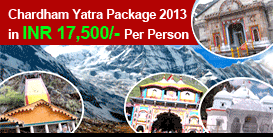
Uttarakhand Packages
Haridwar
Haridwar is situated on the right side of the bank of the holy Ganga, and is the point where the river spreads over the northern plains. Associated with both Lord Shiva and Lord Vishnu, Haridwar is among the seven sacred cities of India. It is also one of the four venues for the Kumbh Mela, held in its magnitude every twelve years. Essentially a religious centre which holds promise of salvation for devotees, Haridwar is also a centre of herbal medicine, and traditional studies at Gurukul Kangri. There are many places of scenic beauty on the outskirts of the town.
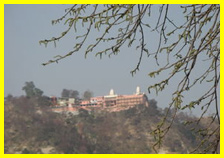
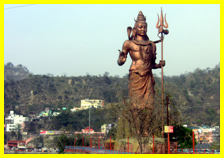
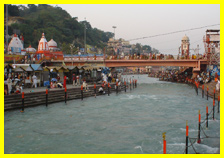
It is said that when the Gods left their footprints on the land of Haridwar, metaphorically they also left an indelible mark on the spiritual ethos of every Hindu – more so, the devout, who would later follow their holy paths all across this blessed land. Haridwar stands as the gateway to the four pilgrimages of Uttrakhand. Mentioned as Mayapuri, Gangadwar, Mokshadwar in the ancient scriptures and epics, Haridwar has always remained as a major Shaktipeeth for the devotees. Of such significance is Haridwar in the thought of India’s traditional Hindus that it has earned its sobriquet of honour, `the gateway to the Gods’.
Legend has it that the holy Ganga, the holiest of all rivers, which flows through this sacred city has actually been sanctified by the powerful Trinity of Hindu mythology and the centre of the pantheon – Lord Brahma, Vishnu and Mahesh.
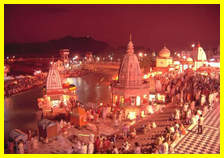 Down the ages, this special importance of Haridwar as the ever-refreshing mystic venue for the purification of the mind, body and soul gained more impetus…and today, manifests into great events that take place here, i.e. the memorable Kumbh Mela which happens once every 12 years and the Ardh Kumbh Mela, which comes once every six years. Yet, beyond the mystic aura and mythology, Haridwar casts another magic spell on the visitor. Being one of the oldest living cities, Haridwar finds its mention in the ancient Hindu scriptures as it weaves through the life and time stretching from the period of Buddha to the more recent British advent.
Down the ages, this special importance of Haridwar as the ever-refreshing mystic venue for the purification of the mind, body and soul gained more impetus…and today, manifests into great events that take place here, i.e. the memorable Kumbh Mela which happens once every 12 years and the Ardh Kumbh Mela, which comes once every six years. Yet, beyond the mystic aura and mythology, Haridwar casts another magic spell on the visitor. Being one of the oldest living cities, Haridwar finds its mention in the ancient Hindu scriptures as it weaves through the life and time stretching from the period of Buddha to the more recent British advent.
Haridwar has not only remained the abode of the weary in body, mind and spirit, but also served as a centre for attraction for many, for learning the arts, science and culture.Haridwar’s longstanding position as a great source for Ayurvedic medicines and herbal remedies as well as its unique Gurukul school of traditional education, the scenic beauty and lush greenery…all give the city a unique flavour and charm; a must among the sojourn centres in a discoverer’s itinerary of Western U.P. – A destination of all seasons.
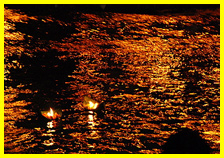 Haridwar is one of the first towns where Ganga emerges from the mountains to touch the plains. And that’s why the water is crystal clear and cool. Lush green forests and small ponds adorns the scenic beauty of this holy land. The Rajaji National Park is just 10 kms from Haridwar. It’s an ideal destination for wildlife and adventure lovers.
Haridwar is one of the first towns where Ganga emerges from the mountains to touch the plains. And that’s why the water is crystal clear and cool. Lush green forests and small ponds adorns the scenic beauty of this holy land. The Rajaji National Park is just 10 kms from Haridwar. It’s an ideal destination for wildlife and adventure lovers.
In the evening the ghats look breathtakingly beautiful, as thousands of diyas and marigold flowers float and illuminate the Holy waters.
Area : 12.302 sq. km.
Population : 3,48,142 (1991 census)
Altitude : 294.70 meters above sea level.
Season : Round the year.
Clothing : Summer - Cottons; Winter - Woollens
Language : Hindi & English
Local Transport : Taxis, Tongas, Tempos, Buses, Cycle-Rikshaws, Auto-Rickshaws
STD Code : 0133



It is said that when the Gods left their footprints on the land of Haridwar, metaphorically they also left an indelible mark on the spiritual ethos of every Hindu – more so, the devout, who would later follow their holy paths all across this blessed land. Haridwar stands as the gateway to the four pilgrimages of Uttrakhand. Mentioned as Mayapuri, Gangadwar, Mokshadwar in the ancient scriptures and epics, Haridwar has always remained as a major Shaktipeeth for the devotees. Of such significance is Haridwar in the thought of India’s traditional Hindus that it has earned its sobriquet of honour, `the gateway to the Gods’.
Legend has it that the holy Ganga, the holiest of all rivers, which flows through this sacred city has actually been sanctified by the powerful Trinity of Hindu mythology and the centre of the pantheon – Lord Brahma, Vishnu and Mahesh.
 Down the ages, this special importance of Haridwar as the ever-refreshing mystic venue for the purification of the mind, body and soul gained more impetus…and today, manifests into great events that take place here, i.e. the memorable Kumbh Mela which happens once every 12 years and the Ardh Kumbh Mela, which comes once every six years. Yet, beyond the mystic aura and mythology, Haridwar casts another magic spell on the visitor. Being one of the oldest living cities, Haridwar finds its mention in the ancient Hindu scriptures as it weaves through the life and time stretching from the period of Buddha to the more recent British advent.
Down the ages, this special importance of Haridwar as the ever-refreshing mystic venue for the purification of the mind, body and soul gained more impetus…and today, manifests into great events that take place here, i.e. the memorable Kumbh Mela which happens once every 12 years and the Ardh Kumbh Mela, which comes once every six years. Yet, beyond the mystic aura and mythology, Haridwar casts another magic spell on the visitor. Being one of the oldest living cities, Haridwar finds its mention in the ancient Hindu scriptures as it weaves through the life and time stretching from the period of Buddha to the more recent British advent. Haridwar has not only remained the abode of the weary in body, mind and spirit, but also served as a centre for attraction for many, for learning the arts, science and culture.Haridwar’s longstanding position as a great source for Ayurvedic medicines and herbal remedies as well as its unique Gurukul school of traditional education, the scenic beauty and lush greenery…all give the city a unique flavour and charm; a must among the sojourn centres in a discoverer’s itinerary of Western U.P. – A destination of all seasons.
 Haridwar is one of the first towns where Ganga emerges from the mountains to touch the plains. And that’s why the water is crystal clear and cool. Lush green forests and small ponds adorns the scenic beauty of this holy land. The Rajaji National Park is just 10 kms from Haridwar. It’s an ideal destination for wildlife and adventure lovers.
Haridwar is one of the first towns where Ganga emerges from the mountains to touch the plains. And that’s why the water is crystal clear and cool. Lush green forests and small ponds adorns the scenic beauty of this holy land. The Rajaji National Park is just 10 kms from Haridwar. It’s an ideal destination for wildlife and adventure lovers.In the evening the ghats look breathtakingly beautiful, as thousands of diyas and marigold flowers float and illuminate the Holy waters.
Area : 12.302 sq. km.
Population : 3,48,142 (1991 census)
Altitude : 294.70 meters above sea level.
Season : Round the year.
Clothing : Summer - Cottons; Winter - Woollens
Language : Hindi & English
Local Transport : Taxis, Tongas, Tempos, Buses, Cycle-Rikshaws, Auto-Rickshaws
STD Code : 0133




















